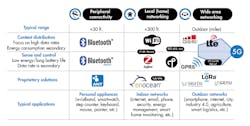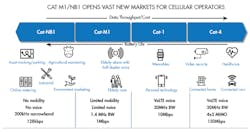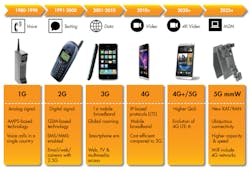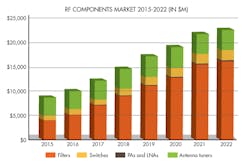It is appropriate that a pioneer in radio-frequency identification (RFID) technology, Kevin Ashon, should have coined the phrase the Internet of Things (IoT). Today, The IoT has move beyond RFID to encompass almost any kind of ubiquitous sensors connecting the physical world to the internet.
This next wave of connectivity technology (including 5G) consists of a seemingly endless variety of use cases and applications, from wearable devices to smart homes. One of the biggest implementation obstacles is the number and variety of competing RF connectivity standards (Fig. 1). The key trade-off among these standards is how much data the designer needs to transmit vs. the distance to transmit—all balanced against the battery life of the system.
Many pundits have pointed out that the IOT is less about “things” and more about new service businesses. Services are the key driver for the IoT, and RF connectivity is enabling these services. Both wireless and cellular networks will be an integral part of the connectivity equation.
“In terms of cellular IOT standards, Cat M1/NB1 is opening vast new markets for cellular operators,” explained Glen Riley, GM, Filter Solutions BU, Qorvo at a recent Semi Pacific NW Forum (Fig. 2). LTE Cat M1 and NB1 are both versions of LTE developed by the 3rd Generation Partnership Project (3GPP). Cat M1/Cat NB1 are targeted at long range, low power, and data rates applications like smart meters and asset tracking.
New mobile standards have occurred about every 10 years, noted Claire Troadec, activity leader, RF Devices and Technologies, Yole Développement—another presenter at the Semi Pacific NW Forum. New standards open new application fields for the end users. For example, the emerging 5th generation mobile networks (or 5G) aims for lower latency than 4G equipment and lower battery consumption, enabling better implementation of the IOT (Fig. 3). Troadec pointed out that the emerging 5G radios will be built upon millimeter wave, new radio access networks (RAN), and radio access technologies (RAT).
The timeline for full 5G implementation is still a few years away. According to a recent report by Dell’Oro Group, RAN revenues will be at their weakest between 2017 and 2021. Initial 5G RANs will be deployed as macro base stations, to be followed by 5G small cells for urban settings. Millimeter-wave services will initially account for less than 5% of carrier spending on the 5G market by 2021.
Disruptive and Enabling 5G
What will be the key disruptive technology trends enabling 5G? It depends upon who you ask. At the recent IEEE IMS 2017 event, a Keysight presentation listed the following as key enabling technologies:
--New Radio (NR) Standard for 5G – separate from LTE. This is the 3GPP standard.
--Spectrum - Other 5G or “pre-5G” air interface specifications including:
- Verizon Pre-5G spec (fixed wireless mm-wave)
- AT&T Pre-5G Trial (fixed wireless mm-wave)
- KT Spec (mobile wireless mm-wave)
--mm-wave and phase array antenna – Complexities will require 20 dB of base-line additional link-budget (or a factor of 100× more power)
--Multiple-Input/Multiple-Output (MIMO) – Will offers significant gains in wireless data rates and link reliability.
--Radio Access Network (RAN) and Core Network – How will legacy and new 5G network architectures interact?
This list tracks closely with the 5G disruptive technologies presented by Qorvo’s Riley:
- Mm-wave spectrum
- Massive MIMO
- Advanced coding and modulation schemes (part of the 5G NR standard)
- Integrated backhaul and cloud-based RAN
From a technology standpoint, Riley pointed out that this will mean higher frequency, wider bandwidth, and higher efficiency power amplifiers (PAs). Other needed components will include low noise floor LNAs, quantized phase shifters and ultra-low jitter clocks. Low-cost mm-wave packaging must also be available, as will ultra-high speed and low power A dc/D ac, high-gain directional antennas and beamforming and very high data rate serial links—like SerDes, TIA, and optical drivers.
The importance of these components was confirmed by Troadec from Yole. The RF component market’s growth will be led by filters and duplexers, representing 72% of the total market in 2020 (see Fig. 4).
Summary
In summary, the IoT is really about services as much as things. These services require connectivity to work. The latest cellular technology for the IoT is 5G, which will enable much faster data, low latency for time critical services (like autonomous cars), and high capacity and bandwidth (for 4K video and cloud storage).
Semiconductor and electronics companies must appreciate that key user case applications, services, and standards are the main drivers behind the IoT and 5G technologies.





